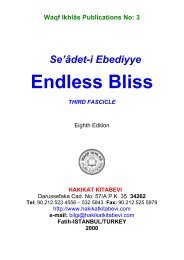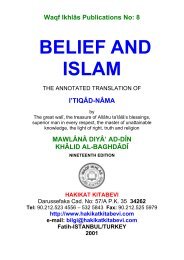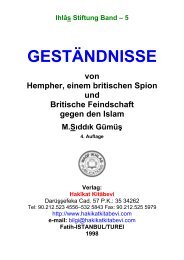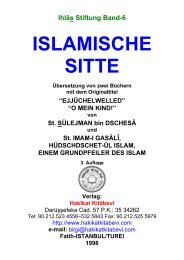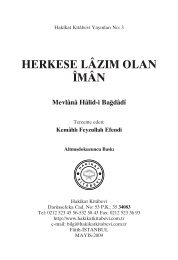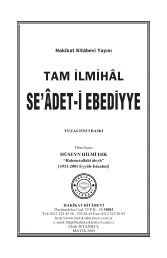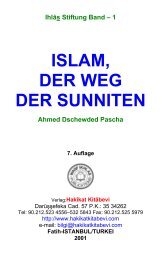5-Endless Bliss Fifth Fascicle - Hakikat Kitabevi
5-Endless Bliss Fifth Fascicle - Hakikat Kitabevi
5-Endless Bliss Fifth Fascicle - Hakikat Kitabevi
Create successful ePaper yourself
Turn your PDF publications into a flip-book with our unique Google optimized e-Paper software.
Beginning with, “Essalâmu ’alaika yâ sayyidî, yâ Rasûlallah...,”<br />
you say the long prayer in the (above-named) book. You say the<br />
salâms sent (by others) through you. Then, first saying the salawât,<br />
you say the prayers you choose. Then, moving one metre to your<br />
right, you greet Hadrat Abû Bakr by saying the long prayer in the<br />
book which begins as, “Essalâmu ’alaika yâ khalîfata<br />
Rasûlillah...” Then, moving half a metre to your right you greet<br />
Hadrat ’Umar by saying the long prayer in the book. Then you pray<br />
for yourself, for your parents, for those who asked you to pray for<br />
them, and for all Muslims. Then you come back opposite<br />
Rasûlullah’s blessed face. You say the prayer in the book and also<br />
other prayers which you will choose. Then you come to the pillar to<br />
which hadrat Abû Lubâba tied himself and made tawba (penance).<br />
Here, and in the Rawda-i-mutahhara, you perform supererogatory<br />
or qadâ salât. You make tawba and pray. At your own discretion,<br />
you should also visit Masjîd-i-Kubâ, Masjîd-i-qiblatayn, the<br />
martyrs of Uhud, the graves at Baqî, and many other sacred<br />
places.”<br />
Ibn Qayyem says, “You say your prayers by turning your back to<br />
Rasûlullah’s grave. Likewise states Abû Hanîfa.” It is written in<br />
Durer-us-seniyya that “Alûsî, too, states so in his tafsîr.” However,<br />
all the savants of Ahl-as sunna write that you say your prayers by<br />
turning toward the blessed grave while putting the qibla wall behind<br />
you. Even Alûsî, who is a follower of Ibni Teymiyya and Ibni<br />
Qayyem, is reasonable enough not to hide the fact, and writes in<br />
his Ghâliya: “After performing two rak’ats of namâz in Masjîd, you<br />
come to the Hujra-i-sa’âda, turn towards his blessed face and,<br />
standing with adab as you would do if he were alive, say salât and<br />
salâm and say the prayers prescribed by the Sharî’a. For,<br />
Rasûlullah is alive in his grave too. Most savants say that it is a<br />
sunna to come from far away places only to visit the blessed grave.<br />
For, a hadîth declares, ‘He who comes to visit me and only<br />
visits me without doing anything else will have the right upon<br />
me that I should intercede for him.’ Another hadîth declares, ’I<br />
acknowledge the greeting of the person who greets me.’”<br />
Abdulhaq-i-Dahlawî ’rahmatullâhi ta’âlâ aleyh’ says in Persian in<br />
his book Jazb-ul-qulûb: As the Masjid-i-sherîf was being built, two<br />
more rooms were built, one for Aisha and one for Sawda<br />
‘radiyallâhu anhumâ’. Then, a room was built for each wedding, and<br />
the number of rooms became nine. It being a custom in Arabia, the<br />
rooms were made of date branches and were roofed with hair felt.<br />
- 126 -



